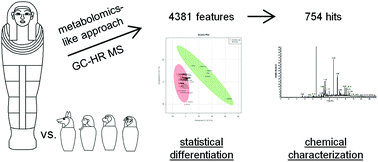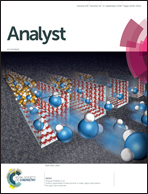Untargeted metabolomics-like screening approach for chemical characterization and differentiation of canopic jar and mummy samples from Ancient Egypt using GC-high resolution MS†
Abstract
In Ancient Egypt it was common practice to embalm corpses and specific internal organs to ensure eternal life. The exact nature of the employed embalming fluids, particularly for organ preservation within the canopic jars, is debated. Therefore, the aim of the current study, was to chemically characterize and differentiate canopic jars (n = 28) and mummies (n = 6) using gas chromatography – high resolution mass spectrometry (GC-HR MS) with a new untargeted metabolomics-like screening approach; as part of a larger minimal-invasive transdisciplinary study on Ancient Egyptian human tissues. Post-analytical data processing included deconvolution, screening against the NIST 14 spectral database as well as a high resolution metabolomics library, and positive peak evaluation. In the majority of samples the presence of a coniferous resin was indicated by the detection of longiborneol in combination with abietadiene acid derivatives and guajacol. Beeswax, proposedly used for symbolic reasons and/or as a binding agent, was detected in 10 samples. Previously not mentioned in the literature, but identified in the current sample set, were medical-related substances like aniseed constituents, salicylic acid, chamazulene and jacobine. By applying an untargeted metabolomics-like approach to archaeological samples for the first time, extensive statistical analysis was made possible (using both identified and non-identified features; adding up to 4381 features), which showed significant differences in the overall chemical composition of canopic jar and mummy samples using principle component analysis (PCA) and partial least square-discriminant analysis (PLS-DA). This emphasizes the necessity for more extensive canopic jar studies in the future in order to interpret findings correctly.



 Please wait while we load your content...
Please wait while we load your content...